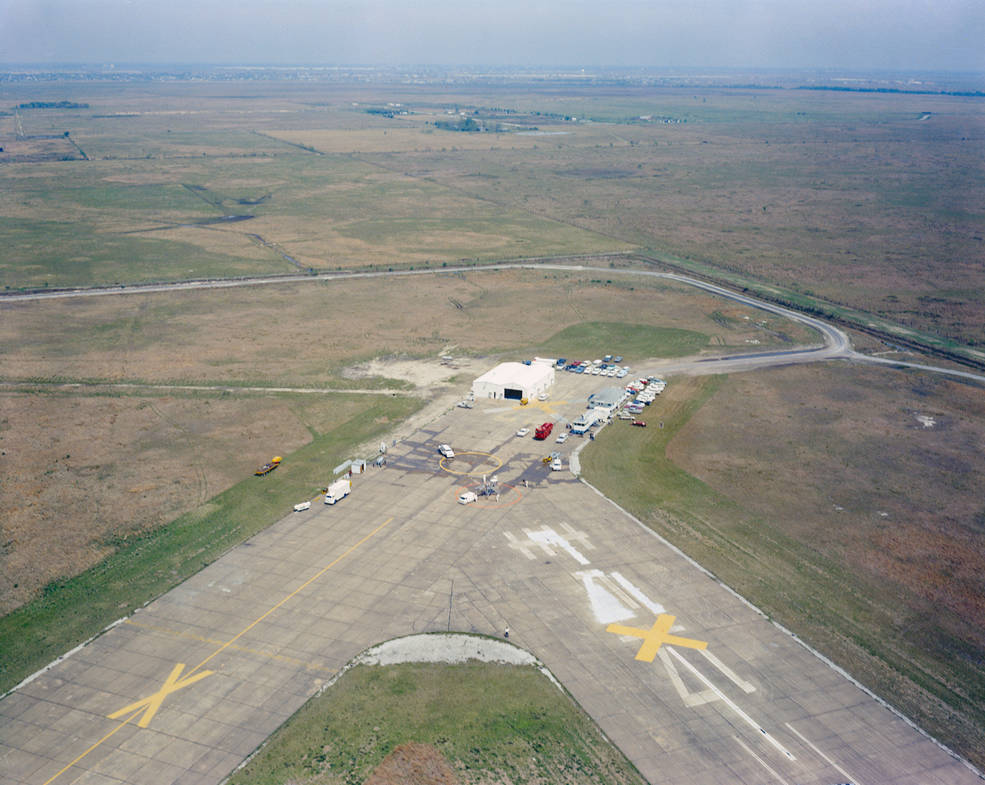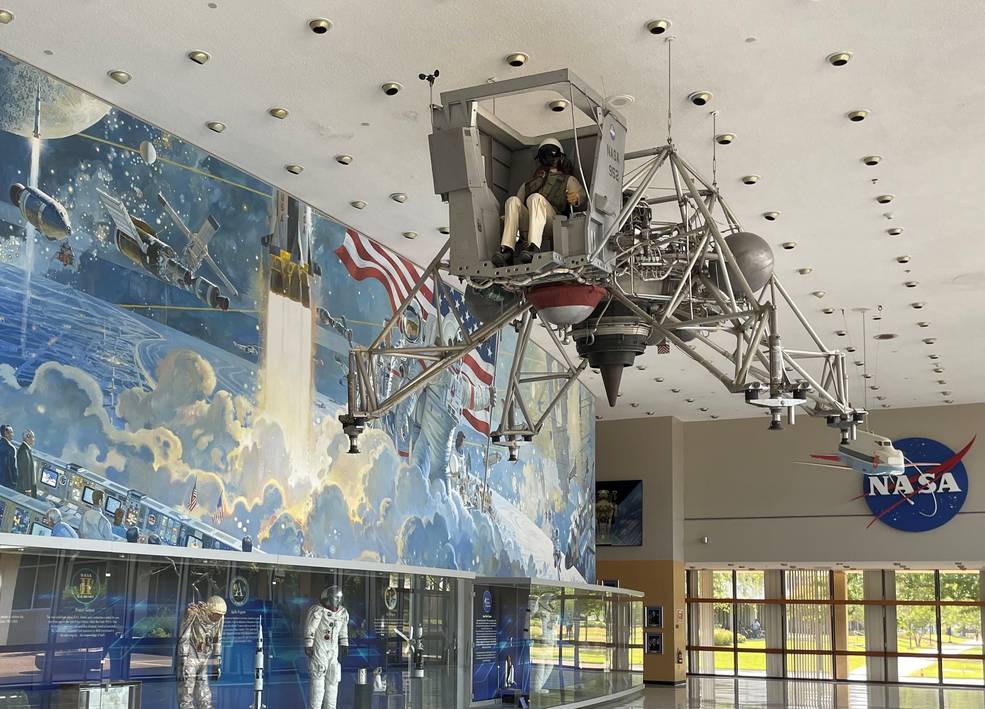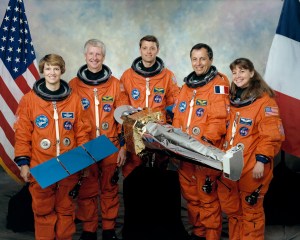On May 6, 1968, NASA astronaut Neil A. Armstrong took off on a simulated lunar landing mission in a Lunar Landing Research Vehicle (LLRV) at Houston’s Ellington Air Force Base (AFB). After about five minutes of nominal flying, the vehicle went out of control.
On May 6, 1968, NASA astronaut Neil A. Armstrong took off on a simulated lunar landing mission in a Lunar Landing Research Vehicle (LLRV) at Houston’s Ellington Air Force Base (AFB). After about five minutes of nominal flying, the vehicle went out of control. About 200 feet above the ground, Armstrong chose to eject. While the LLRV crashed and burned on impact, Armstrong parachuted safely to the ground and suffered no injuries. An accident investigation board determined that a loss of helium pressure caused depletion of the hydrogen peroxide used for the reserve attitude thrusters. The vehicle’s instrumentation did not provide adequate warning about the adverse situation. Engineers corrected the problems before flights resumed in October, using an updated version of the craft called the Lunar Landing Training Vehicle (LLTV).



Left: The northeast corner of Ellington in Houston set aside for Lunar Landing Research
Vehicle (LLRV) testing. Middle: Pilots Harold E. “Bud” Ream and Joseph S. Algranti pose
in front of LLRV-1 at Ellington. Right: Astronaut Neil A. Armstrong poses
with LLRV-1 in March 1967 at Ellington.
One of the most difficult tasks to accomplish President John F. Kennedy’s goal of landing a man on the Moon and returning him safely to the Earth involved the actual lunar landing. The LLRV and its successor the higher-fidelity LLTV allowed Apollo astronauts to master the intricacies of the final descent to the Moon’s surface by simulating the Lunar Module’s (LM) performance. Under contract to NASA, Bell Aerosystems of Buffalo, New York, built two LLRVs and three LLTVs, the latter providing more accurate simulations of the LM’s flying characteristics. The open-framed LLRV and LLTV used a downward pointing turbofan engine to counteract five-sixths of the vehicle’s weight to simulate lunar gravity and LM-like thrusters for attitude control. The astronauts could thus simulate maneuvering and landing on the lunar surface while still on Earth. The two LLRVs completed a thorough testing program at Dryden (now Armstrong) Flight Research Center at Edwards AFB in California between 1964 and 1967. Following the test program, during which LLRV-1 completed 198 flights and LLRV-2 six flights, NASA transferred them to Ellington in December 1966 and January 1967, respectively, where LLRV-1 completed 84 flights, 46 piloted by astronauts, with LLRV-2 kept as a reserve vehicle. NASA pilots Harold E. “Bud” Ream and Joseph S. Algranti first flew LLRV-1 to certify it before astronauts began their training flights. The first LLTV arrived at Ellington in October 1967, followed by two more vehicles in December.



Left: Armstrong flying LLRV-1 at Ellington shortly before the May 6, 1968, crash.
Middle: Armstrong ejecting from the vehicle just seconds before it crashed.
Right: Armstrong parachuting to safety after ejecting from LLRV-1
which is seen burning on the ground after its crash.
As one of several astronauts learning to fly the LLRV in a remote area in the northeast corner of Ellington, Armstrong made his first flight aboard LLRV-1 on March 27, 1967. By the time Armstrong began his 22nd flight on May 6, 1968, NASA had assigned him as the backup commander for Apollo 9, then planned as a mission to test the Command and Service Modules and the LM in a high-altitude Earth orbit. That morning, Armstrong took off in LLRV-1 on a simulated lunar landing mission. After flying for about five minutes, the vehicle suddenly went out of control. As Armstrong fought to regain control, the aircraft lost altitude and about 200 feet above the ground, he chose to eject. While the LLRV crashed and burned on impact, Armstrong parachuted safely to the ground and suffered no injuries, reportedly back in his office later that day. Robert L. Gilruth, director of the Manned Spacecraft Center, now NASA’s Johnson Space Center in Houston, appointed an accident investigation board, chaired by Aircraft Operations Office Chief and experienced LLRV pilot Algranti. The investigation revealed that a loss of helium pressure caused depletion of the hydrogen peroxide used for the reserve attitude thrusters. The vehicle’s instrumentation did not provide adequate warning about the adverse situation. Engineers corrected the problems before flights resumed in October 1968, using LLTV-1. A crash two months later ended that vehicle’s short career, and once again NASA management grounded the fleet until an investigation identified the problem and engineers corrected it. Management cleared Armstrong, now assigned as commander of Apollo 11, to fly LLTV-2 in June 1969, and he completed his final training flight just three weeks prior to launch. Armstrong completed 21 flights in the LLRV and 6 in the LLTV, valuable experience that allowed him to successfully guide the LM Eagle to the lunar surface on July 20, 1969, meeting President Kennedy’s goal of landing a man on the Moon before the end of the decade.


Left: Aerial view of the crashed Lunar Landing Training Vehicle-1 (LLTV-1) at
Ellington in Houston. Right: Ground level view of the crashed LLTV-1 at Ellington.
All prime and backup Apollo Moon landing commanders completed training in the LLTV, and those who landed a LM on the Moon attributed their success to this training. Apollo 8 astronaut William A. Anders called the ungainly contraption, dubbed the “flying bedstead,” “a much unsung hero of the Apollo Program.” Armstrong said of the LLTV: “(The LM) Eagle flew very much like the Lunar Landing Training Vehicle which I had flown more than 30 times…. I had made from 50 to 60 landings in the trainer, and the final trajectory I flew to the landing was very much like those flown in practice. That of course gave me a good deal of confidence – a comfortable familiarity.” Summarizing its usefulness to the Apollo training program, Armstrong said: “It was a contrary machine, and a risky machine, but a very useful one.” Apollo 12 commander Charles “Pete” Conrad said, “I think everybody agreed that the LLTV was essential to a successful landing.” Apollo 15 Commander David R. Scott attributed his successful landing to “the time that I had to work with the LLTV.” Apollo 16 Commander John W. Young described his landing on the Moon as “just like flying the LLTV.” Apollo 17 Commander Eugene A. Cernan said the LLTV provided very valuable “training in the critical final phases of the descent.”


Left: Workers move LLRV-2 from the Armstrong Flight Research Center for display at
the Air Force Test Flight Museum at Edwards Air Force Base. Right: LLTV-3 suspended
over the lobby of the Teague Auditorium at NASA’s Johnson Space Center in Houston.
The remaining LLRV-2 is on display at the Air Force Flight Test Museum at Edwards Air Force Base (on loan from the Armstrong Flight Research Center). The remaining LLTV-3 is on display at JSC, suspended over the lobby of the Teague Auditorium.




























